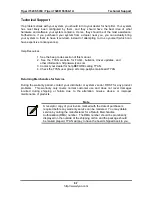
Tiger i7320 / Tiger i7320R Appendix I: Glossary
6-2
http://www.tyan.com
Cache size
: refers to the physical size of the cache onboard. This should not be confused with
the cacheable area, which is the total amount of memory which can be scanned by the system
in search of data to put into the cache. A typical setup would be a cache size of 512KB, and a
cacheable area of 512MB. In this case, up to 512KB of the main memory onboard is capable
of being cached. However, only 512KB of this memory will be in the cache at any given
moment. Any main memory above 512MB could never be cached.
Closed and open jumpers:
jumpers and jumper pins are active when they are “on” or
“closed”, and inactive when they are “off” or “open”.
CMOS (Complementary Metal-Oxide Semiconductors):
chips that hold the basic startup
information for the BIOS.
COM port:
another name for the serial port, which is called as such because it transmits the
eight bits of a byte of data along one wire, and receives data on another single wire (that is,
the data is transmitted in serial form, one bit after another). Parallel ports transmit the bits of a
byte on eight different wires at the same time (that is, in parallel form, eight bits at the same
time).
DDR (Double Data Rate):
is a technology designed to double the clock speed of the memory.
It activates output on both the rising and falling edge of the system clock rather than on just
the rising edge, potentially doubling output.
DIMM (Dual In-line Memory Module):
faster and more capacious form of RAM than SIMMs,
and do not need to be installed in pairs.
DIMM bank:
sometimes called DIMM sockets, because the physical slot and the logical unit
are the same. That is, one DIMM module fits into one DIMM socket, which is capable of acting
as a memory bank.
DMA (Direct Memory Access):
channels that are similar to IRQs. DMA channels allow
hardware devices (like soundcards or keyboards) to access the main memory without
involving the CPU. This frees up CPU resources for other tasks. As with IRQs, it is vital that
you do not double up devices on a single line. Plug-n-Play devices will take care of this for you.
Doze mode:
in this mode, only the CPU’s speed is slowed.
DRAM (Dynamic RAM): widely available, very affordable form of RAM which has the
unfortunate tendency to lose data if it is not recharged regularly (every few milliseconds). This
refresh requirement makes DRAM three to ten times slower than non-recharged RAM such as
SRAM.
ECC (Error Correction Code or Error Checking and Correcting):
allows data to be
checked for errors during run-time. Errors can subsequently be corrected at the same time
that they’re found.
EEPROM (Electrically Erasable Programmable ROM):
also called Flash BIOS, is a ROM
chip which can, unlike normal ROM, be updated. This allows you to keep up with changes in
the BIOS programs without having to buy a new chip. TYAN’s BIOS updates can be found at
http://www.tyan.com







































